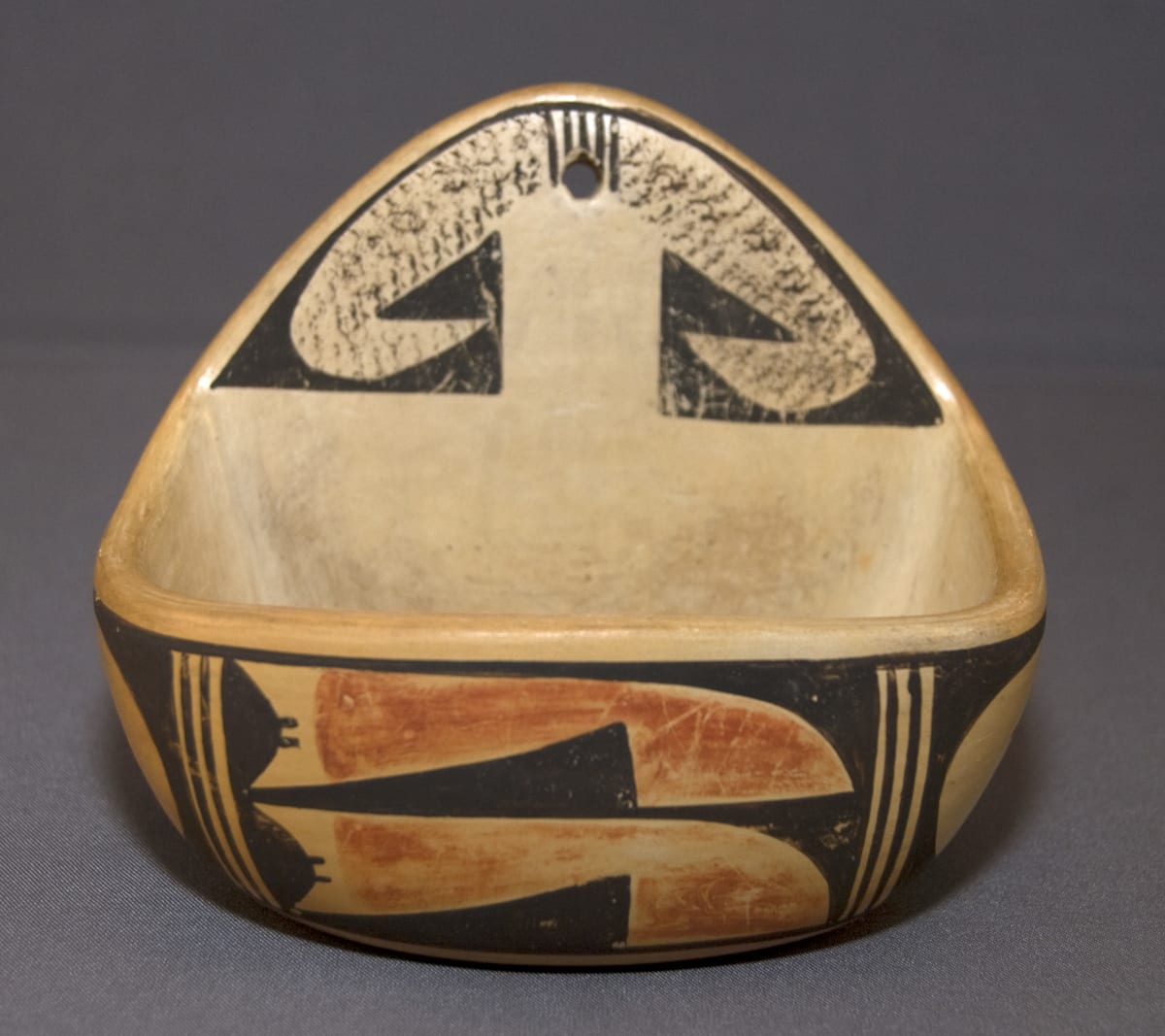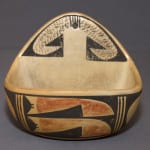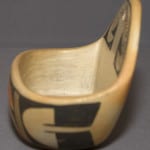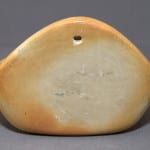This pot is beautifully formed, painted and fired. The form is graceful and well proportioned. The painting is simple but elegant. The pot is nicely blushed from the outdoor firing. The red paint on the front panel was lightly applied or has faded or worn, giving this color a warm, gentle look. The uneven, somewhat transparent red color suggests the pot may have been made before 1930, when the Museum of Northern Arizona Hopi show began to insist on more robust, solid colors.
Sikyatki Revival pottery is often characterized by what Lydia Wyckoff called “figure-ground reversal…when you look at the pot the figure and the background against which it is placed keep changing places, the figure becomes the background and the background becoming the figure (1985:100).” One’s eye sees both of these designs at the same time and flicks back and forth between them, giving the design energy. Every painted element on pot 2011-02 displays figure-ground reversal.
For example, much of the design on the rear flange of the pot is stippled. A thin black design surrounds this stippled area and forms a negative image of the design. One’s eye sees the stippled area as the main design, then changes view and the surrounding black design become predominant. Moreover, the shape of the painting on the flange mirrors the shape of the clay flange, adding a second dimension of visual tension.
The painting of the wall pocket is monochromatic, except for two red areas on the front. Intruding into and surrounding these red areas are a series of black elements and these compete with the red forms as the predominant design. The eye has difficulty defining what is the central motif and what is the background. Similarly, the designs on the ends of pot 2011-02 are black but imbedded in these elements is a mushroom-shaped unpainted area. One’s eye is able to see either as the central motif. The front and side panels of design are separated by two vertical black lines forming three unpainted stripes. Overall, then, all elements of the design on pot 2011-02 are engaged in this Escher-like eye play that titillates ones eyes.
As I understand it, the Hopi and Hopi/Tewa feel themselves to be participants in a spirit-and-meaning-permeated universe. Central to this universe is farming and central to farming is corn.
Farming is obviously an economic activity; for the Hopi it is also a religious activity. The ways of farming were established by the god Maasaw; the hard work of dry farming ties the Hopi to myths of emergence into this fourth world. Planting with a digging stick is a sacred act. Maasaw is the god of death and also ruler of the earth. Thus there is a sense of process: life emerges from death. Human birth is likened to the sprouting of a kernel of corn. The twenty days of isolation for a newborn is seen a parallel to the time needed to sprout and form a new plant. Symbolically people are corn. The Hopi word qatungwu refers both to the human corpse and a harvested corn plant (Loftin, 1991: 4-11 and 28-32). Corn links daily activity with the sacred. Indeed, for the Hopi, they are expressions of the same reality and corn is at the center of it all.
Thus it is not surprising that cornmeal (“hooma”) traditionally is central to ritual life:
“Cornmeal was once used by the Hopi on an everyday basis. Each morning as he went out to pray toward the rising sun he made it a habit to pray with hooma…When there is a ritual in progress and prayers are being conducted, cornmeal is involved….(W)hen one goes to deposit a paaho (prayer stick) one always takes cornmeal along. Before the paaho is deposited, one first prayers to it using cornmeal. This accounts for the expression hom’oyto, ‘he is going to deposit cornmeal’ (Malotki and Lomatuway’ma, 1987:275-277).” The use of holy water by the Catholic Church as a medium for bestowing blessings is similar to the use of cornmeal in Hopi society.
Recounting a traditional Hopi tale, Ekkehart Malotki describes two women using cornmeal as a morning blessing:
“The next morning the girl was up early, gathering her bedding. When the old woman heard that, she also got up. Then she asked the girl to accompany her outside to speak the morning prayer. Both of them helped themselves to some cornmeal; then they went out and prayed in the direction of the rising sun (2002:114-115).”
I can find no reference in the literature to the use of cornmeal wall pockets like 2011-02. Indeed I find only one published photographs of such pots (Hayes and Blom, 1998:60). I have seen small bowls filled with cornmeal in Hopi homes. Some of these pots had a flange back with a hole like pot 2011-02 and were hung from a nail on the wall, sometimes near a door. I assume that cornmeal wall pockets like 2011-02 are used to hold cornmeal that is used in daily practice to bless each new day.
For another pot with corn as a central theme, see 2010-16.





